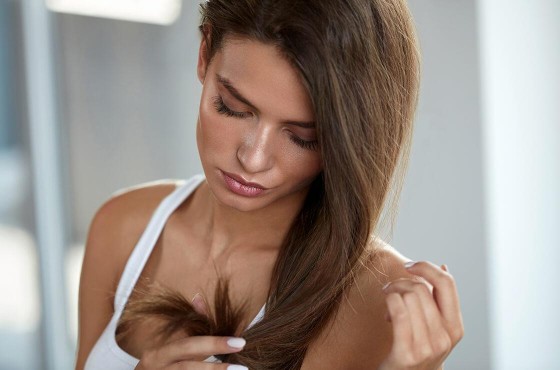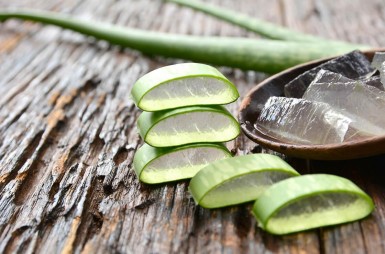Restoring beauty to damaged hair
Written by Marion, Aesthetician/Cosmetician | published on | updated on 17/04/2024

Is your hair brittle, coarse and dull? Is it difficult to style with split ends? If you have damaged hair, it is essential to understand its structure and what it needs so that you can care for it effectively.
The structure of hair
Biologically speaking, the visible part of our hair - the part that plays such an important role in our appearance - is not actually “alive” at all.
The living part is the root (or hair follicle), which is located 4 mm beneath the surface of the scalp. The root comprises a hair bulb with the dermal papilla at its base, which is permeated by small blood vessels supplying nutrients to the cells. A little higher up, a sebaceous gland ensures that the growing hair is well lubricated.
The “dead” part is called the shaft, comprising three concentric layers. At the centre is the soft medulla, which varies in thickness and is sometimes not found in fine hair. Cells without nuclei form this layer. The middle layer is the cortex, made up of 80 or 90 % keratin as well as melanin. This layer gives the hair its suppleness and strength, as well as its colour. The outer layer comprises overlapping keratin scales and protects the hair from external damage and dehydration.
What are the stages of the hair growth cycle?
Each strand of hair starts life in the hair bulb, where the keratinocyte and melanocyte cells multiply. As the bulb grows larger, the cells are pushed closer towards the epidermis, where they emerge as hair shafts. The period during which a strand of hair grows is known as the anagen stage, which lasts between 3 and 7 years and sees the hair grow 1 to 2 cm per month. This is followed by the catagen stage during which growth pauses for a few weeks before the telogen stage starts, which is when the individual hairs fall out. This cycle lasts approximately six months.
The typical scalp has around 150,000 individual strands of hair, varying in diameter from 50 to 100 micrometres. The hair bulb determines whether your hair is straight or curly: a flatter bulb will result in curly hair while a round bulb is responsible for straight hair.
Why does hair turn grey?
Some people spot their first grey hair during their twenties, while others are still enjoying their natural colour at the age of 50. This is mainly down to genetics. However, everyone will experience their hair turning grey at some point in their lives. Why is this the case? It happens because the melanin-producing melanocyte cells lose their effectiveness over time. As they become less effective, they are less able to counter the effect of the hydrogen peroxide contained in the scalp, which also destroys the melanocytes. A number of factors can accelerate their demise, particularly all the oxidative stress factors, an iron deficiency, stress and anxiety.
What damages our hair?
Throughout the anagen years, the hair is subjected to numerous external stressors which it can withstand to a greater or less extent, depending on its thickness, strength and the quality of its outer layer. The structure of the hair will be more robust if it has obtained sufficient nutrients, if you are not a smoker and you haven't experienced excessive oxidative stress, exhaustion or emotional upheaval. These are the “internal” factors. However, there are also external stressors: pollution, overexposure to sunlight, excessive brushing or the use of unsuitable appliances that break or pull out your hair, excessive washing which strips the hair of protective sebum, products such as those containing silicone which prevent the hair from breathing. Heat sources from appliances such as straighteners and curling tongs should also be used sparingly.
How can you improve the texture of damaged hair?
Improving your damaged hair It is not possible to genuinely repair or nourish the hair shaft, as it is not “alive”. However, you can improve the overall appearance of damaged hair.
The best place to start is by trimming the split ends. This will make your hair neater and prevent it from continuing to split.
What is the best solution for restoring the suppleness and shine to damaged hair? Don’t wash it too often (once or twice a week should suffice) and choose gentle products that won’t strip nutrients from the hair. Follow this up with effective moisturising, protective products designed for damaged hair, based on simple, natural ingredients, like those found at Cocooncenter: products containing plant oils such as castor oil, serums and masks for damaged hair, etc.
How can I encourage the growth of healthy hair?
You need to focus on the part of the hair that you can’t see: the hair bulb, where it all starts. Nutrition has an important part to play. Nutrients that help to promote healthy hair growth include vitamin C (for strong hair), vitamin A (for its effective lubrication properties), zinc (for the production of keratin), iron (for oxygenation and cell stability), the B group vitamins (for cellular growth), sulphur (for keratin synthesis) and omega 3 fatty acids.
All of these nutrients can be obtained through a balanced diet, but optimal concentrations are available as food supplements if you do have a deficiency. There are also lotions that can be applied to the scalp. Finally, it is vital to limit your exposure to sunlight and to anything that might “burn” or damage the hair, including hair dryers, straighteners, curling tongs, perms and colouring.
We were not made equal when it comes to our hair. Some people enjoy luxuriant locks, while others have a less impressive head of hair. Whichever camp you fall into, it is vital to protect your hair both inside and out to keep it looking attractive.
Three key takeaways in relation to damaged hair:
- A good haircut will give you a fresh start by removing the most damaged areas.
- Highly effective products are available to thicken your hair and restore its softness and shine without adding extra weight. Cocooncenter has the best range of products to care for your very damaged hair!
- When it comes to subsequent hair growth, enjoying a balanced diet and healthy lifestyle and treating your hair with care will encourage the growth of healthy locks!






















